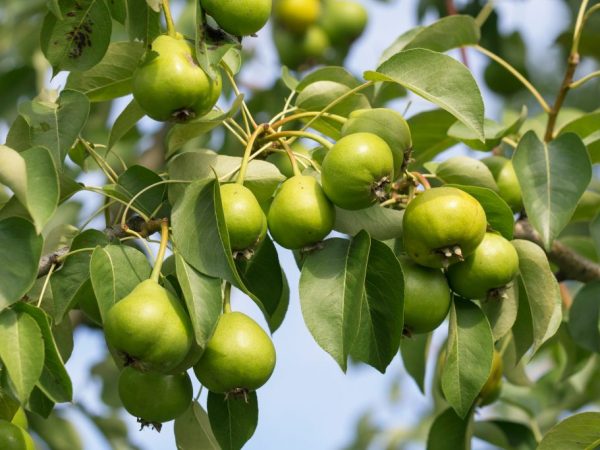Description pear Williams
Pear Williams was bred in Beckshire (England) back in 1796. After a while, they began to grow it in France, and later in other European countries. Today Williams has several varieties at once: Summer (Duchess, Bartlett), Winter (Curé) and Red (Rouge Delbara).

Description pear Williams
Characteristics of the variety
Williams pears have excellent fruit taste, therefore the variety is considered dessert. In order for the plant to give good yields, the participation of pollinators is necessary, among which there are quince, as well as the varieties Lyubimitsa Klappa and Forest Beauty.
According to the description, Williams pear trees begin to bear fruit at 3-5 years of age. The fruits ripen closer to mid-August.
Cure and Rouge Delbara pears can be stored for up to 2 months, preserving their taste and useful properties. They are used for making desserts and pastries, pear compotes and jams, drying and fruit salads. Due to the health benefits and low calorie content, they are recommended for overweight people and those who follow the figure.
Description of subspecies
It is believed that the first to appear was the late-ripening variety known as Kure or Plebanovka.
Winter Williams (Curé)
Pear Williams Winter is more common in warm regions, since constant cold has a bad effect on the taste of the fruit. Short-term cold does not seriously injure the plant, as a result, they retain the ability to bear fruit well.
The plants are strong and tall. Their wide and dense crown has a pyramidal shape. During active fruiting, the branches fall down under the weight of the fruits, since the yield is quite high. Leaves are colored deep green, thick
The variety has abundant flowering, the ovary is well formed. The flowers are white-pink in color, large. The best pollinators are Duchess and Olivier de Ser.
According to the description, the fruits are slightly oblong and rather large. Their weight ranges from 150 to 250 g. The skin has a deep yellow color, on which a longitudinal brown stripe often appears. The pulp is juicy and grainy, has a sweet and sour taste and a light aroma.
Summer Williams (Duchess)
Pear Williams Summer is considered one of the best, due to its abundant harvest, so the period of active growth of the plant ends at the age of 10-12 years.
The Williams pear variety begins to bloom late enough. The first fruits ripen towards the end of August and the beginning of September. They are harvested before full ripening to prolong storage.
Fruits are medium in size, weighing about 150-160 g. They are distinguished by excellent taste and pleasant pear aroma. The pulp is juicy, slightly sour, but very sweet.
Williams Red
Pear Williams Red has a neat crown. She has a high yield, the period of active ripening begins at the end of August. The fruits are oblong and large or medium in size: from 150 to 200 g.Their yellow color is almost completely covered by a rich burgundy blush. The pulp is sweet, juicy, melting and tender.
Landing rules

Pear needs sunlight
Young trees are planted in early spring or in autumn (at the end of the growing season). To do this, choose a sunny place without drafts.
The standard dimensions of the planting pit are about 80 cm deep and 60 cm in diameter. A pre-prepared mixture is poured to the bottom, which consists of garden soil and humus (1: 1) with the addition of 350 g of superphosphate and 350 g of potassium sulfate.
The plant is well inspected and pre-soaked in a solution that stimulates root growth for 5-12 hours. After that, the seedling is carefully lowered into the hole and covered with soil. A peg is driven in next to the trunk, to which the plant is tied. The soil is lightly tamped and moisturized well.
Care
Plant care is standard, it consists in timely watering, fertilizing, pruning trees and preparing them for winter.
Watering
Young Williams plants, regardless of subspecies, need frequent watering during the first 2-3 years (3-4 times a week). Watering of mature trees is carried out much less often, depending on the growing conditions, from 3 to 6-7 times per season.
Top dressing
Before the beginning of fruiting, the trees are fed annually in the spring. This includes mulching with manure with the addition of 100 g of azophoska. Adult plants are fertilized in the fall. During digging, mineral fertilizing in combination with organic matter is introduced into the soil. You can carry out additional feeding before the start of fruiting.
Pruning
The first pruning of a young plant is carried out in early spring. Leave from 4 to 5 lateral shoots and shorten them to 30 cm. Adult plants are pruned twice: in the fall they carry out sanitary pruning, in the spring - rejuvenating (thinning).
Recommendations
Williams Rouge Delbara and Duchess pears have medium resistance to low temperatures, therefore they are recommended to be covered for the winter. It is necessary to loosen the soil in areas where trees grow and remove weeds regularly.
Diseases and pests
The most common diseases that affect Williams pears can be identified.
- Scab - greenish-black spots on fruits and leaves. In order to avoid the disease, it is necessary to regularly remove fallen leaves from the site. A good result is guaranteed by spraying trees with colloidal sulfur and copper sulfate.
- Cytosporosis is a depressed reddish-brown spot on the trunk. The affected area is cleaned and disinfected with Bordeaux liquid.
- Rust - spots on the leaves that later form swellings. To combat the disease, a 2% solution of colloidal sulfur is used.
- Fruit rot.
Among insect pests, there are sucker, aphids, pear bugs and gall mites.
Conclusion
The red, summer and winter varieties of Williams pears have a number of characteristics, among which each gardener, depending on the method of harvesting, climatic conditions and personal preferences, will be able to choose the right one.


